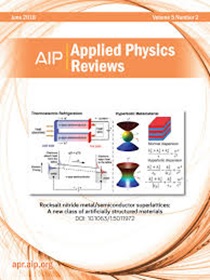Voltage-controlled magnetic anisotropy in Pt/Fe/MgO and 2D dielectric LaOBr-capped Pt/Fe/MgO heterostructures
IF 11.6
1区 物理与天体物理
Q1 PHYSICS, APPLIED
引用次数: 0
Abstract
Low power consumption and fast response enabled by voltage control are core advantages of field-effect transistors. Similarly, in magnetoelectric random access memory (MeRAM), voltage-controlled magnetic anisotropy (VCMA) offers comparable advantages in assisting or directly inducing magnetization switching. Enhancing the VCMA coefficient is essential for fully realizing this functionality. In this work, first-principles calculations reveal that the Pt/Fe/MgO heterostructure exhibits a significant VCMA coefficient (β = −4394 fJ/V·m), which is mainly contributed by the Pt layer. It has been demonstrated that the large VCMA coefficient originates from four indispensable determinants associated with the Pt layer: (1) the strong spin–orbit coupling constant, (2) the high induced spin polarization, (3) electron accumulation/depletion on the Pt layer, and (4) the presence of Pt dz2 orbital states near the Fermi level. In consideration of practical application scenarios, Pt/Fe/MgO was further capped with an Au electrode layer and a dielectric BaTiO3 layer. However, the calculated results reveal a significant reduction in the VCMA coefficient for both structures. In contrast, introducing a 2D dielectric material, LaOBr, as a gate layer atop Pt/Fe/MgO, a comparably large VCMA coefficient (β = −4373 fJ/V·m) is obtained. This is attributed to the van der Waals nature of the LaOBr/Pt interface, which allows the Pt layer to meet the four determinants mentioned above. The insights into the factors governing the VCMA coefficient and the design of the LaOBr/Pt/Fe/MgO heterostructure provide valuable guidance for the development of next-generation, high-performance MeRAM devices with large VCMA.电压控制的Pt/Fe/MgO和二维介质labr_capped Pt/Fe/MgO异质结构的磁各向异性
低功耗和快速响应的电压控制是场效应晶体管的核心优势。同样,在磁电随机存取存储器(MeRAM)中,电压控制磁各向异性(VCMA)在辅助或直接诱导磁化开关方面具有类似的优势。提高VCMA系数是充分实现这一功能的必要条件。第一性原理计算表明,Pt/Fe/MgO异质结构具有显著的VCMA系数(β = - 4394 fJ/V·m),这主要是由Pt层贡献的。结果表明,较大的VCMA系数来源于与Pt层相关的四个不可缺少的决定因素:(1)强自旋-轨道耦合常数,(2)高诱导自旋极化,(3)Pt层上的电子积累/耗尽,以及(4)Pt dz2轨道态在费米能级附近的存在。考虑到实际应用场景,在Pt/Fe/MgO表面进一步覆盖了Au电极层和介电BaTiO3层。然而,计算结果显示两种结构的VCMA系数都有显著降低。相反,在Pt/Fe/MgO上引入二维介电材料LaOBr作为栅极层,得到了较大的VCMA系数(β = - 4373 fJ/V·m)。这归因于LaOBr/Pt界面的范德华性质,它允许Pt层满足上面提到的四个决定因素。对影响VCMA系数的因素和LaOBr/Pt/Fe/MgO异质结构设计的深入了解,为开发具有大VCMA的下一代高性能MeRAM器件提供了有价值的指导。
本文章由计算机程序翻译,如有差异,请以英文原文为准。
求助全文
约1分钟内获得全文
求助全文
来源期刊

Applied physics reviews
PHYSICS, APPLIED-
CiteScore
22.50
自引率
2.00%
发文量
113
审稿时长
2 months
期刊介绍:
Applied Physics Reviews (APR) is a journal featuring articles on critical topics in experimental or theoretical research in applied physics and applications of physics to other scientific and engineering branches. The publication includes two main types of articles:
Original Research: These articles report on high-quality, novel research studies that are of significant interest to the applied physics community.
Reviews: Review articles in APR can either be authoritative and comprehensive assessments of established areas of applied physics or short, timely reviews of recent advances in established fields or emerging areas of applied physics.
 求助内容:
求助内容: 应助结果提醒方式:
应助结果提醒方式:


